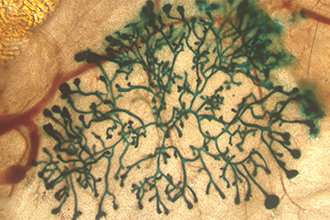New breast cell types discovered by multidisciplinary research team

A joint effort by breast cancer researchers and bioinformaticians has provided new insights into the molecular changes that drive breast development.
The research team compared genes expressed in single cells in the mammary gland (breast tissue) to understand the broad molecular changes that occur during development. This revealed a dramatic shift in gene expression around the onset of puberty, and allowed the team to identify previously unrecognised cell types cells in the breast.
At a glance
- The breast develops from stem cells, with dramatic changes occurring at puberty to prepare the mammary gland for milk production.
- Our researchers have shown many parallels between normal breast development and breast cancer formation.
- Using a new technology called single-cell transcriptomics, a multidisciplinary research team was able to define previously unknown changes in gene expression in the developing breast.
How does the breast develop?
An Institute research team including Dr Bhupinder Pal, Dr Yunshun Chen and Dr François Vaillant, led by Professor Jane Visvader, Professor Gordon Smyth and Professor Geoff Lindeman, investigated the molecular changes that occur as the breast develops. Their research was published in Nature Communications.
Professor Visvader, who jointly leads the Institute's breast cancer research program with Professor Lindeman, said the team focused on changes in the breast before, during and after puberty. "We compared which genes were expressed by the breast cells – their transcriptome – on a global level by profiling thousands of cells," she said. "This allowed us to uncover a huge change in the transcriptional program that occurs near puberty, which is the time when cells commit to become different types of adult cells. Prior to this time, in the pre-pubertal breast, the cells are all in a relatively similar and immature state."
Professor Visvader said that the findings had important implications for understanding how breast cancers arise.
"This sort of technology can be applied to understanding which cells go awry in women at in increased risk for developing breast cancer. Moreover, this technology provides a new way of investigating breast cancer heterogeneity in much greater depth," Professor Visvader said.
Zooming in to single cells
A key to the discovery was a new technology called single-cell RNA-sequencing, in which the researchers could determine the transcriptomes of hundreds to thousands of cells, said Professor Gordon Smyth, head of the Institute's Bioinformatics division.
"We were able to apply our expertise in bioinformatics to differentiate the diverse populations of cells in the breast," Professor Smyth said. "This revealed striking changes in the gene expression programs that contribute to breast development."
An important aspect of the research was that it used two different transcriptomics technologies available at the Institute. One technology platform enabled in-depth sequencing of hundreds of cells, while the other enabled thousands of cells to be sequenced, albeit in less depth.
"This dual approach using two sequencing platforms allowed us to comprehensively investigate the research question, more powerfully than we could have using either platform alone," said Professor Smyth.
The power of collaboration
Professor Lindeman said the research was a wonderful success story for multi-disciplinary collaboration between biologists, bioinformaticians and technology specialists. "The expertise across multiple divisions at the Institute was critical to our team's discoveries," Professor Lindeman said.
"The future of biology lies in collaboration, and in applying novel technologies solve to complex problems and reveal new levels of detail in how our bodies work. This is just one example of the power and potential of multi-disciplinary research."
More information: Bhupinder Pal et al. Construction of developmental lineage relationships in the mouse mammary gland by single-cell RNA profiling, Nature Communications (2017). DOI: 10.1038/s41467-017-01560-x





















